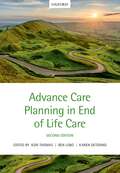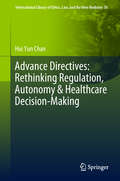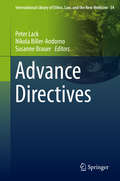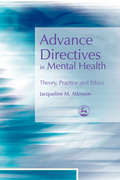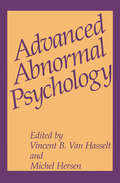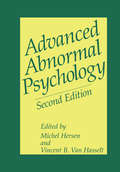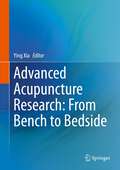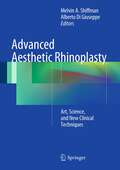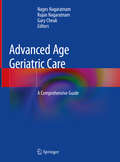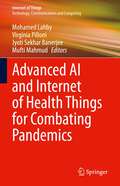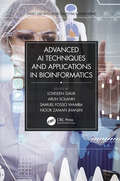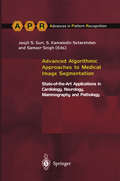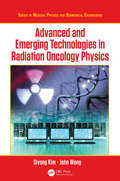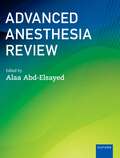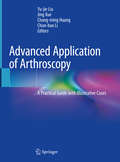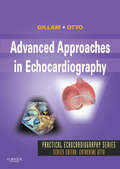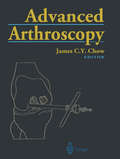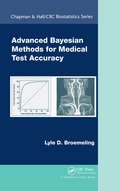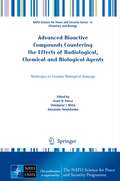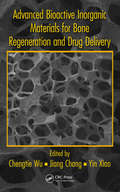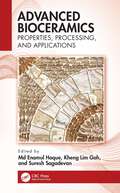- Table View
- List View
Advance Care Planning in End of Life Care
by Keri Thomas, Ben Lobo and Karen DeteringAdvance Care Planning (ACP) is an essential part of end of life care in the UK and most developed countries. It enables more people to live well and die as they would choose, and has significant implications for the individual person, their family and carers, and our wider society. In the context of an ageing population and increasing possibilities for medical interventions, ACP is a particularly important aspect of quality care. Expanded and fully updated throughout, this new edition gives a comprehensive overview of ACP and explores a wide range of issues and practicalities in providing end of life care. Written by experts from around the world, the book takes a comprehensive look at the subject by exploring the wide range of issues and practicalities in providing ACP; framing the purpose, process, and outcomes of these plans; and providing an important update on national and international research, policy and practice. Chapters also discuss values, goals and priorities, and include detailed case examples to aid best practice. This book is an invaluable resource for all clinicians involved in the caring for people in their final stages of life. It is of particular value to GPs, palliative care specialists, geriatricians, social care teams, researchers and policy leads interested in improving end of life care.
Advance Care Planning in End of Life Care
Advance Care Planning (ACP) is an essential part of end of life care in the UK and most developed countries. It enables more people to live well and die as they would choose, and has significant implications for the individual person, their family and carers, and our wider society. In the context of an ageing population and increasing possibilities for medical interventions, ACP is a particularly important aspect of quality care. Expanded and fully updated throughout, this new edition gives a comprehensive overview of ACP and explores a wide range of issues and practicalities in providing end of life care. Written by experts from around the world, the book takes a comprehensive look at the subject by exploring the wide range of issues and practicalities in providing ACP; framing the purpose, process, and outcomes of these plans; and providing an important update on national and international research, policy and practice. Chapters also discuss values, goals and priorities, and include detailed case examples to aid best practice. This book is an invaluable resource for all clinicians involved in the caring for people in their final stages of life. It is of particular value to GPs, palliative care specialists, geriatricians, social care teams, researchers and policy leads interested in improving end of life care.
Advance Directives: Rethinking Regulation, Autonomy & Healthcare Decision-Making (International Library of Ethics, Law, and the New Medicine #76)
by Hui Yun ChanThis book offers a new perspective on advance directives through a combined legal, ethical and philosophical inquiry. In addition to making a significant and novel theoretical contribution to the field, the book has an interdisciplinary and international appeal. The book will help academics, healthcare professionals, legal practitioners and the educated reader to understand the challenges of creating and implementing advance directives, anticipate clinical realities, and preparing advance directives that reflect a higher degree of assurance in terms of implementation.
Advance Directives (International Library of Ethics, Law, and the New Medicine #54)
by Peter Lack Nikola Biller-Andorno Susanne BrauerThis volume gives an overview on the currently debated ethical issues regarding advance directives from an international perspective. It focuses on a wider understanding of the known and widely accepted concept of patient self-determination for future situations. Although advance directives have been widely discussed since the 1980s, the ethical bases of advance directives still remain a matter of heated debates. The book aims to contribute to these controversial debates by integrating fundamental ethical issues on advance directives with practical matters of their implementation. Cultural, national and professional differences in how advance directives are understood by health care professions and by patients, as well as in laws and regulations, are pinpointed.
Advance Directives in Mental Health: Theory, Practice and Ethics (PDF)
by Jacqueline AtkinsonAn advance directive is a way of making a person's views known if he or she should become mentally incapable of giving consent to treatment, or making informed choices about treatment, at some future time. Advance Directives in Mental Health is a comprehensive and accessible guide for mental health professionals advising service users on their choices about treatment in the event of future episodes of mental illness, covering all ideological, legal and medical aspects of advance directives. Jacqueline Atkinson explains their origins and significance in the context of mental health legislation and compares advance directives in mental health with those in other areas of medicine like dementia or terminal illness, offering a general overview of the differences in the laws of various English-speaking countries. She explores issues of autonomy and responsibility in mental health and gives practical advice on how to set up, implement and change advance directives. The book offers a useful overview of advance directives and is a key reference for all mental health professionals as well as postgraduate students, lawyers who work with mentally ill people, service users and their families and carers.
Advanced Abnormal Psychology
by Michel Hersen Vincent B. Van HasseltAlthough senior undergraduate psychology students and first year master's- and doctoral-level students frequently take courses in advanced abnormal psychology, it has been almost two decades since a book by this title has appeared. Professors teaching this course have had a wide variety of texts to select from that touch on various aspects of psychopathology, but none has been as comprehensive for the student as the present volume. Not only are basic concepts and models included, but there are specific sections dealing with childhood and adolescent disorders, adult and geriatric disorders, child treatment, and adult treatment. We believe the professor and advanced student alike will benefit from having all the requisite material under one cover. Our book contains 26 chapters presented in five parts, each part preceded by an editors' introduction. The chapters reflect updates in the classification of disorders (i. e. , DSM-IV). In Part I (Basic Concepts and Models), the chapters include diagnosis and classification, assessment strategies, research methods, the psychoanalytic model, the behavioral model, and the biological model. Parts II (Childhood and Adolescent Disorders) and III (Adult and Older Adult Disorders), bulk of the book. To ensure cross each containing seven chapters, represent the chapter consistency, each of these chapters on psychopathology follows an identi cal format, with the following basic sections: description of the disorder, epidem iology, clinical picture (with case description), course and prognosis, familial and genetic patterns, and diagnostic considerations.
Advanced Abnormal Psychology
by Michel Hersen Vincent B. Van HasseltAlthough senior undergraduate psychology students and first year master's-and doctoral-level students frequently take courses in advanced abnormal psychology, it has been almost two decades since a book by this title has appeared. Professors teaching this course have had a wide variety of texts to select from that touch on various aspects of psychopathology, but none has been as comprehensive for the student as the present volume. Not only are basic concepts and models included, but there are specific sections dealing with childhood and adolescent dis orders, adult and geriatric disorders, child treatment, and adult treatment. We believe the professor and advanced student alike will benefit from having all the requisite material under one cover. Our book contains 26 chapters presented in five parts, each part preceded by an editors' introduction. The chapters reflect updates in the classification of disorders (i. e. , DSM-IV). In Part I (Basic Concepts and Models), the chapters include diagnosis and classfication, assess ment strategies, research methods, the psychoanalystic model, the behavioral model, and the biological model. Parts II (Childhood and Adolescent Disorders) and III (Adult and Older Adult Disorders), each containing seven chapters, represent the bulk of the book. To ensure cross-chapter consistency, each of these chapters on psychopathology follows an identical format, with the following basic sections: description of the disorder, epidemiology, clinical picture (with case description), course and prognosis, familial and genetic patterns, and diag nostic considerations.
Advanced Acupuncture Research: From Bench to Bedside
by Ying XiaWritten by over seventy scientists and clinicians worldwide from China, USA, Germany, Canada, Japan and other countries, this monograph, with nearly 450 figures and tables, covers a wide range of advanced progress in acupuncture research, from experimental research to clinical applications. In addition to exploring the histopathological basis for acupuncture and mathematical simulation of acupoint response to stimulation, initiation and transduction of acupuncture signals and cellular mechanisms during acupuncture effects as well as chemical and physical characteristics of moxibustion on acupoints are broadly discussed. The topics also include novel data on acupuncture effect with advanced imaging techniques, a unique understanding of meridian-viscera correlation, specific interactions between meridians and neurosensory organs within the system of homeostatic regulation and the acupuncture-induced influences on autonomic function. Several chapters introduce specific approaches with dry needling, silver needling and stainless needling for certain diseases, such as myofascitis, supportive care for breast cancer and chemotherapy-induced peripheral neuropathy as well as perioperative care of surgical patients. Moreover, this book discusses recent research on acupuncture therapy and potential mechanisms for a number of severe and refractory neurological disorders, including hyperactivity of hypothalamic-pituitary-adrenal axis, orofacial pain, chronic pain, itch, multiple sclerosis, autism spectrum disorders, cerebral palsy, depressive disorders, Alzheimer’s disease and ischemic brain injury. The vast amount of information offered in this book provides a comprehensive perspective on advanced acupuncture research to not only acupuncturists, but also to neuroscientists, neurologists, and other clinicians. For medical students and graduate and undergraduate students majoring in biology, physiology and neuroscience, this book offers an advanced course in learning about the mechanism-driven advances in alternative and complementary medicine.
Advanced Aesthetic Rhinoplasty: Art, Science, and New Clinical Techniques
by Melvin A. Shiffman and Alberto Di GiuseppeAesthetic rhinoplasty is among the most common aesthetic operations in the field of facial aesthetic plastic surgery, but it is also viewed as one of the most complex. This comprehensive book provides a wealth of up-to-date information on advanced aesthetic rhinoplasty techniques. After discussion of anatomy, psychological issues, and preoperative planning, a wide range of primary and secondary rhinoplasty techniques are described clearly and in detail with the aid of numerous high-quality color illustrations. The use of fillers in rhinoplasty, ethnic variations in anatomy and techniques, and possible risks and complications are all clearly explained. This book is intended primarily for experienced surgeons in the fields of plastic surgery, cosmetic surgery, general surgery, otolaryngology, ophthalmology, oral maxillofacial surgery, and cosmetic surgical subspecialties. It will also be an invaluable resource for residents and fellows.
Advanced Age Geriatric Care: A Comprehensive Guide
by Nages Nagaratnam Kujan Nagaratnam Gary CheukAs the Baby Boomers age, concerns over healthcare systems' abilities to accommodate geriatric patients grow increasingly challenging. This is especially true with the population deemed to be “the oldest of the old,” specifically those over the age of 85. Unlike any other time in history, this demographic is the fastest growing segment of most developed countries. In the United States the oldest old is projected to double from 4.3 million to 9.6 million by 2030. The increased life expectancy of the population since the early 1900s has been built on the improvement of living conditions, diet, public health and advancement in medical care. With this we have seen a steady decline in the age-specific prevalence of vascular and heart diseases, stroke and even dementia. Older persons are healthier today than their counterparts decades ago. More importantly than in any other age group, the care of the oldest old must be individualized; management decisions should be made taking into consideration the older persons’ expressed wishes, quality of life, function and mental capacity. The inevitable consequence is that there will be an increase in the prevalence of older persons with chronic diseases, multiple co-existing pathologies and neuro-degenerative diseases. The oldest of the aging population are often excluded from drug trials and their treatments are largely based on findings extrapolated from that of the younger old. Furthermore, among the oldest old, physiologically they are more diverse than other segments of the population. Their demographic characteristics are unparalleled and different compared to that of the younger old. Several studies have drawn attention to the differing attitudes among health professionals towards elderly people and many show prejudice because they are old. As a result, the use of age as a criteria in determining the appropriateness of treatment is of very limited validity, yet there are limited resources that guide physicians through these challenges. This book creates a greater awareness of these challenges and offers practical guidelines for working within the infrastructures vital to this demographic. This book is designed for geriatricians, primary care physicians, junior medical officers, specialty geriatrics nurses, and gerontologists. It is divided into 3 sections: General Considerations, Chronic diseases and Geriatric Syndromes. Each chapter provides a summary of important and essential information under the heading of Key Points. Case studies are included in some of the chapters to highlight the principles of management.
Advanced AI and Internet of Health Things for Combating Pandemics (Internet of Things)
by Mohamed Lahby Virginia Pilloni Jyoti Sekhar Banerjee Mufti MahmudThis book presents the latest research, theoretical methods, and novel applications in the field of Health 5.0. The authors focus on combating COVID-19 or other pandemics through facilitating various technological services. The authors discuss new models, practical solutions, and technological advances related to detecting and analyzing COVID-19 or other pandemic based on machine intelligence models and communication technologies. The aim of the coverage is to help decision-makers, managers, professionals, and researchers design new paradigms considering the unique opportunities associated with computational intelligence and Internet of Medical Things (IoMT). This book emphasizes the need to analyze all the information through studies and research carried out in the field of computational intelligence, communication networks, and presents the best solutions to combat COVID and other pandemics.
Advanced AI Techniques and Applications in Bioinformatics (Smart and Intelligent Computing in Engineering)
by Loveleen Gaur Arun Solanki Samuel Fosso Wamba Noor Zaman JhanjhiThe advanced AI techniques are essential for resolving various problematic aspects emerging in the field of bioinformatics. This book covers the recent approaches in artificial intelligence and machine learning methods and their applications in Genome and Gene editing, cancer drug discovery classification, and the protein folding algorithms among others. Deep learning, which is widely used in image processing, is also applicable in bioinformatics as one of the most popular artificial intelligence approaches. The wide range of applications discussed in this book are an indispensable resource for computer scientists, engineers, biologists, mathematicians, physicians, and medical informaticists. Features: Focusses on the cross-disciplinary relation between computer science and biology and the role of machine learning methods in resolving complex problems in bioinformatics Provides a comprehensive and balanced blend of topics and applications using various advanced algorithms Presents cutting-edge research methodologies in the area of AI methods when applied to bioinformatics and innovative solutions Discusses the AI/ML techniques, their use, and their potential for use in common and future bioinformatics applications Includes recent achievements in AI and bioinformatics contributed by a global team of researchers
Advanced AI Techniques and Applications in Bioinformatics (Smart and Intelligent Computing in Engineering)
by Loveleen Gaur, Arun Solanki, Samuel Fosso Wamba and Noor Zaman JhanjhiThe advanced AI techniques are essential for resolving various problematic aspects emerging in the field of bioinformatics. This book covers the recent approaches in artificial intelligence and machine learning methods and their applications in Genome and Gene editing, cancer drug discovery classification, and the protein folding algorithms among others. Deep learning, which is widely used in image processing, is also applicable in bioinformatics as one of the most popular artificial intelligence approaches. The wide range of applications discussed in this book are an indispensable resource for computer scientists, engineers, biologists, mathematicians, physicians, and medical informaticists. Features: Focusses on the cross-disciplinary relation between computer science and biology and the role of machine learning methods in resolving complex problems in bioinformatics Provides a comprehensive and balanced blend of topics and applications using various advanced algorithms Presents cutting-edge research methodologies in the area of AI methods when applied to bioinformatics and innovative solutions Discusses the AI/ML techniques, their use, and their potential for use in common and future bioinformatics applications Includes recent achievements in AI and bioinformatics contributed by a global team of researchers
Advanced Algorithmic Approaches to Medical Image Segmentation: State-of-the-Art Applications in Cardiology, Neurology, Mammography and Pathology (Advances in Computer Vision and Pattern Recognition)
Medical imaging is an important topic and plays a key role in robust diagnosis and patient care. It has experienced an explosive growth over the last few years due to imaging modalities such as X-rays, computed tomography (CT), magnetic resonance (MR) imaging, and ultrasound. This book focuses primarily on model-based segmentation techniques, which are applied to cardiac, brain, breast and microscopic cancer cell imaging. It includes contributions from authors working in industry and academia, and presents new material.
Advanced and Emerging Technologies in Radiation Oncology Physics (Series in Medical Physics and Biomedical Engineering)
by Siyong Kim John WongThis new book educates readers about new technologies before they appear in hospitals, enabling medical physicists and clinicians to prepare for new technologies thoroughly and proactively, and provide better patient care once new equipment becomes available. Emerging technologies in imaging, treatment planning, treatment delivery, dosimetry and informatics are all discussed. The book is divided into three parts: recently developed technologies available for practice; technologies under development nearing completion; and technologies in an early stage of development that could have potential radiotherapy applications. Features: Introduces emerging technologies in imaging, treatment planning, treatment delivery, dosimetry and informatics The advantages and limitations of each technology in clinical settings are discussed, and recommendations on how to adopt the technologies are provided Critiques and improvement points are provided for researchers, in addition to suggestions on how to prepare quality assurance are provided as needed
Advanced and Emerging Technologies in Radiation Oncology Physics (Series in Medical Physics and Biomedical Engineering)
by Siyong Kim John W. WongThis new book educates readers about new technologies before they appear in hospitals, enabling medical physicists and clinicians to prepare for new technologies thoroughly and proactively, and provide better patient care once new equipment becomes available. Emerging technologies in imaging, treatment planning, treatment delivery, dosimetry and informatics are all discussed. The book is divided into three parts: recently developed technologies available for practice; technologies under development nearing completion; and technologies in an early stage of development that could have potential radiotherapy applications. Features: Introduces emerging technologies in imaging, treatment planning, treatment delivery, dosimetry and informatics The advantages and limitations of each technology in clinical settings are discussed, and recommendations on how to adopt the technologies are provided Critiques and improvement points are provided for researchers, in addition to suggestions on how to prepare quality assurance are provided as needed
Advanced Anesthesia Review
by Alaa Abd-ElsayedAdvanced Anesthesia Review provides a comprehensive knowledge review for all second-year US Anesthesiology residents taking the American Board of Anesthesiology's (ABA) Advanced Exam. A companion to Basic Anesthesia Review, this essential review features concise and readable chapters covering the relevant knowledge and concepts as determined by the ABA's curriculum. While multiple books are available for board review, very few have published since the ABA restructured board examinations. Advanced Anesthesia Review is organized topically according to the most recently published ABA curriculum and highlights ABA key words along with bulleted key points to reinforce key concepts and facts.
Advanced Anesthesia Review
Advanced Anesthesia Review provides a comprehensive knowledge review for all second-year US Anesthesiology residents taking the American Board of Anesthesiology's (ABA) Advanced Exam. A companion to Basic Anesthesia Review, this essential review features concise and readable chapters covering the relevant knowledge and concepts as determined by the ABA's curriculum. While multiple books are available for board review, very few have published since the ABA restructured board examinations. Advanced Anesthesia Review is organized topically according to the most recently published ABA curriculum and highlights ABA key words along with bulleted key points to reinforce key concepts and facts.
Advanced Application of Arthroscopy: A Practical Guide with Illustrative Cases
by Yu-Jie Liu Jing Xue Chang-Ming Huang Chun-Bao LiThis book provides arthroscopy techniques and applications to clinical practitioners, including sports medicine therapeutics, orthopaedic surgeons, specialist training candidates, rehabilitation clinicians. It also includes small incisions per minimally invasive surgery using a camera mounted on a thin tube to visualize, repair and reconstruct joint-associated structures. Arthroscopy technique as a minimally invasive surgical method, in Orthopeadics is not only for the treatment of intra-articular diseases but also an advanced conception for treatment of extra-articular diseases and peri-articular fractures. After performing years of arthroscopy, authors intend to provide an elite technique demonstration of each procedure, including indications, technique, complications, and results. There are three main parts of the book, including the extra-articular application of arthroscopy techniques, arthroscopic minimally invasive techniques for the treatment of intra-articular fractures, and Innovative technology for repair and reconstruction of bone and joint injuries. Key technical points and experience of arthroscopic repair of joint injuries, dislocation of joints, fixation of the intra-articular fractures, ligament release for limbs are illustrated. Special situations such as congenital torticollis, deltoid contracture, gluteal muscle contracture, bone grafting, removal of locking plate and screw and benign tumors treatment are also included.
Advanced Approaches in Echocardiography - E-Book (Practical Echocardiography)
by Linda D. Gillam Catherine M. OttoAdvanced Approaches in Echocardiography- a volume in the exciting new Practical Echocardiography Series edited by Dr. Catherine M. Otto - provides practical, how-to guidance on advanced and challenging echocardiographic techniques such as 3D echo, contrast echo, strain echo, and intracardiac echo. Definitive, expert instruction from Drs. Linda D. Gillam and Catherine M. Otto is presented in a highly visual, case-based approach that facilitates understanding and equips you to master these difficult and cutting-edge modalities. Access the full text online at www.expertconsult.com along with cases, procedural videos and abundant, detailed figures and tables that show you how to proceed, step by step, and get the best results.Master new and advanced echocardiography techniques such as 3D echocardiography, contrast echocardiography, strain echocardiography, and intracardiac echocardiography through a practical, step-by-step format that provides a practical approach to image acquisition and analysis, technical details, pitfalls, and case examples. Tap into the knowledge and experience of two noted authorities in the field: Dr. Linda D. Gillam, former president of the American Society of Echocardiography, and world-renowned echocardiography expert and author Dr. Catherine M. Otto. Reference the information you need quickly thanks to easy-to-follow, templated chapters, with an abundance of figures and tables that facilitate visual learning. Online access includes the complete text, illustrations, video clips, additional cases, and much more!
Advanced Arthroscopy
by R. W. Jackson James C. Y. ChowFocusing on the most current, cutting-edge, innovative, and advanced arthroscopic techniques for wrist and hand, elbow, shoulder, hip, knee, ankle, foot, and spine, this book presents orthopaedic surgeons with the detailed procedures needed to stay competitive in the age of managed care. With contributions from specialist leaders in orthopaedic and arthroscopic surgery, the text is supplemented by full-color arthroscopic views and custom illustrations, detailing complex procedures for rotator cuff tear, TFCC repair, meniscus repair, ACL reconstruction, intraarticular fractures and many others. Special sections on laser applications in arthroscopy and office arthroscopy make this volume a must for every practicing orthopaedic surgeon.
Advanced Bayesian Methods for Medical Test Accuracy
by Lyle D. BroemelingUseful in many areas of medicine and biology, Bayesian methods are particularly attractive tools for the design of clinical trials and diagnostic tests, which are based on established information, usually from related previous studies. Advanced Bayesian Methods for Medical Test Accuracy begins with a review of the usual measures such as specificity
Advanced Bioactive Compounds Countering the Effects of Radiological, Chemical and Biological Agents: Strategies to Counter Biological Damage (NATO Science for Peace and Security Series A: Chemistry and Biology)
by Grant N. Pierce, Volodymyr I. Mizin and Alexander OmelchenkoThe probability for exposure to damaging radiation, toxic chemicals in the environment and adverse biological agents has increased exponentially today. The more frequent and faster travel that we experience today also escalates the risk of contraction and transmission of potentially deadly infections. This has created a very real and escalating risk for injuries and deaths. This is accentuated in the military and medical staff that is more frequently exposed to radiological, chemical, and biological agents in their normal working environment. Understanding the mechanisms whereby these toxic agents inflict damage to our bodies is essential to prepare us for these challenges. Much of the damage is inflicted through the generation of free radicals and non-radical oxidants which then act through oxidative mechanisms to injury the body. This volume will discuss the damage caused by these radiological, chemical, and biological environmental stressors, the mechanisms through which the damage can occur and the novel strategies that can be used to reduce the injury inflicted by these toxic compounds. Using basic and clinical research approaches, the contents of this book discuss new ideas for the development of bioactive products and environmental approaches to lessen or negate the biological damage inflicted by these noxious compounds.
Advanced Bioactive Inorganic Materials for Bone Regeneration and Drug Delivery
by Chengtie Wu Jiang Chang Yin XiaoBioceramics play an important role in repairing and regenerating defective or damaged bone. Annually, more than 500,000 bone graft procedures are performed in the United States and approximately 2.2 million are conducted worldwide. Advanced Bioactive Inorganic Materials for Bone Regeneration and Drug Delivery reviews the latest advances in the fiel
Advanced Bioceramics: Properties, Processing, and Applications
by M. Enamul Hoque Kheng Lim Goh Suresh SagadevanAdvanced Bioceramics: Properties, Processing, and Applications describes development of bioceramics and biocomposites, which are used in various biomedical applications including bone tissue repair, remodelling and regeneration. It covers the fundamental aspects of materials science and bioengineering, clinical performance in a variety of applications, ISO/ASTM specifications, and opportunities and challenges. • Offers a comprehensive view of properties and processing of bioceramics. • Highlights applications in dentistry, orthopaedic and maxillofacial implants, and regenerative and tissue engineering. • Covers ISO/ASTM specifications such as processing, clinical applications, recycling/reuse and disposal standards. • Explores health, environmental and ethical issues. With contributions from eminent editors and recognized authors around the world, this book should serve as an important reference for academics, scientists, researchers, students and practitioners in materials science and biomedical engineering. It is to assist in the design of novel, targeted and personalised bioceramic-based solutions to advanced healthcare.
